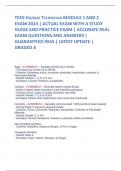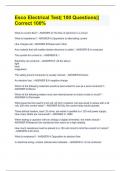TEEX HAZMAT TECHNICIAN MODULE 1 AND 2
EXAM 2024 | ACTUAL EXAM WITH A STUDY
GUIDE AND PRACTICE EXAM | ACCURATE REAL
EXAM QUESTIONS AND ANSWERS |
GUARANTEED PASS | LATEST UPDATE |
GRADED A
Bags - ✔✔ANSW✔✔..- Typically contains up to 100 lbs
- Tote bags may contain up to 500 lbs
- Contains: Explosives, toxics, corrosives, pesticides, insecticides, oxidizers, &
flammable Materials
- Hazard Classes: 1, 4, 5, 6, 8, & 9
- Examples: Cement, Fertilizers, & pesticides
Carboys - ✔✔ANSW✔✔..- Generally doesn't exceed 20 gal
- Glass or plastic bottles encased in outer protective packaging
- Contains: toxics, acidic or caustic corrosives, and water
- Hazard Classes: 1, 3, 5, 6, 8, & 9
- Examples: Sulfuric Acid, Hydrochloric acid, Ammonium Hydroxide
Cylinders - ✔✔ANSW✔✔..- Generally will not exceed 1,000 pounds of water capacity
- Internal Press: A few psi to several hundred
- Contains: Toxics, Corrosives, Pesticides, Insecticides, Oxidizers, & Flammable
Materials
- Hazard Classes: 2, 3, & 6
- Examples: Aerosol Containers, Cleaners, Lubricants, Paints, & toiletries
Non-Insulated Cylinders:
- Contains: Acetylene, Gaseous Nitrogen, LPG or Oxygen
Cryogenic Cylinders:
- Hazard Class: 2
- Examples: Argon, Helium, Nitrogen, & Oxygen
,Threshold Limit Value-Ceiling (TLV-C) - ✔✔ANSW✔✔..Maximum concentration to
which healthy adult can be exposed w/o risk of injury
Comparable to IDLH
Threshold Limit Value- Short Term Exposure Limit (TLC-STEL) - ✔✔ANSW✔✔..Max
concentration averaged over 8 hours to which a healthy adult can be repeatedly
exposed for 8 hr/day, 40 hr/wk
Radiation Absorbed Dose (rad) - ✔✔ANSW✔✔..Used to measure a quantity called
absorbed dose
Roentgen (R)
(Ran-kin) - ✔✔ANSW✔✔..Unit of exposure to ionizing radiation
Roentgen Equivalent Man (REM), Millirem (mrem), and Microrem (μrem) -
✔✔ANSW✔✔..Rem is a large amount of radiation, so the mrem, which is one
thousandth of a rem is often the dosage encountered
Sievert (Sv), Millisevert (mSv), Microsievert (μSv) - ✔✔ANSW✔✔..Sievert is unit of
radiation absorbent. mSv is one thousandth of an Sv, & the μSv is one millionth of an Sv
Time: Shorter time of exposure, lower dosage received
Distance: Further from the source, less exposure
Shielding: PPE can only protect against alpha particles. Shielding materials include,
Lead, cement, and even water
Exposure Routes - ✔✔ANSW✔✔..Absorption: Absorbed into body through skin or other
external tissues
Ingestion: Process of consuming contaminated food or water
Inhalation: Toxins enter body through the lungs
Injection: Toxic substance introduced directly into the blood by a needle, cannula, or
some other mechanical means
Target Organ Effects - ✔✔ANSW✔✔..Reference Table 1.3, Pg 1-119
Dose Response - ✔✔ANSW✔✔..Refers to manner in which the body reacts to toxic
substance exposure. Response will depend on the concentration of exposure at the
site, material itself, and the dose administered
, Synergistic Effects - ✔✔ANSW✔✔..Results from the interaction of more than one
product
Response Objectives - ✔✔ANSW✔✔..1. Rescue
2. Public Protective Actions
3. Spill Control, Leak Control, Fire Control
Offensive Strategy - ✔✔ANSW✔✔..Response options performed directly on the
container or stressed system to mitigate the incident.
Containment: act of stopping the release and preventing the spread of affected
materials
Drums and Barrels - ✔✔ANSW✔✔..- Generally wont exceed 55 gal
- Open Head Drum: removable head
- Closed Head Drum: two openings, one 2in & 1 0.75in that are closed with plugs
- Contains: Toxics, Corrosives, Pesticides, Insecticides, Oxidizers, & Flammable
Materials
- Hazard Classes: 1, 3, 4, 5, 6, 8, & 9
- Examples: Lubricating Grease, Caustic Powders, Hydrogen Peroxide, Poisons &
Solvents
Ton Containers - ✔✔ANSW✔✔..- Max Capacity: Transport 1 ton
- Internal Pressure: 100-500 psi
- Possible Contents: Liquified gases & some nonflammable gases
- Moderate BLEVE Potential
- Hazard Class: 2.2 (anhydrous ammonia) & 2.3 (Poisonous Gas)
- Examples: Chlorine, Sulfur Dioxide, Phosgene, & Anhydrous Ammonia
- Other Information:
-- Convex design usually contains refrigerant gases
-- Concave usually contains Chlorine, Phosgene & other gasses
Flexible Intermediate Bulk Containers - ✔✔ANSW✔✔.."Super Sacks"
- Capacity: 500 - 5,000 lbs
- Possible Contents: Solid materials including explosives, flammable solids, oxidizers,
and organic peroxides, poisons, & corrosives
- Hazard Classifications: 1.5, 4, 5, 6, 8, & 9
- Examples: Fertilizers, Pesticides, Caustic Powders, & Water Treatment Chemicals
Rigid Intermediate Bulk Containers - ✔✔ANSW✔✔..- Capacity: 300-500 gal
- Possible Contents: Liquid materials including corrosives
- Hazard Classes: 8 & 9
- Examples: Acrylic Acid, Butyric Acid, Hydroic Acid, Sodium Aluminate, Asbestos &
Sulfur





